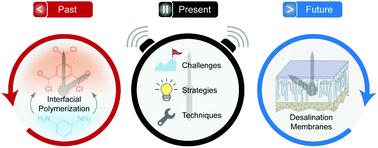当前位置:
X-MOL 学术
›
Chem. Soc. Rev.
›
论文详情
Our official English website, www.x-mol.net, welcomes your feedback! (Note: you will need to create a separate account there.)
Fabrication of desalination membranes by interfacial polymerization: history, current efforts, and future directions
Chemical Society Reviews ( IF 40.4 ) Pub Date : 2021-4-13 , DOI: 10.1039/d0cs00502a Xinglin Lu 1 , Menachem Elimelech
Chemical Society Reviews ( IF 40.4 ) Pub Date : 2021-4-13 , DOI: 10.1039/d0cs00502a Xinglin Lu 1 , Menachem Elimelech
Affiliation

|
Membrane desalination is a promising technology for addressing the global challenge of water scarcity by augmenting fresh water supply. Continuous progress in this technology relies on development of membrane materials. The state-of-the-art membranes used in a wide range of desalination applications are polyamide thin-film composite (TFC) membranes which are formed by interfacial polymerization (IP). Despite the wide use of such membranes in desalination, their real-world application is still hampered by several technical obstacles. These challenges of the TFC membranes largely stem from the inherent limitations of the polyamide chemistry, as well as the IP reaction mechanisms. In the past decade, we have witnessed substantial progress in the understanding of polyamide formation mechanisms and the development of new IP strategies that can potentially lead to the redesign of TFC membranes. In this Tutorial, we first present a brief history of the development of desalination membranes and highlight the major challenges of the existing TFC membranes. We then proceed to discuss the pros and cons of emerging IP-based fabrication strategies aiming at improving the performance of TFC membranes. Next, we present technical obstacles and recent efforts in the characterization of TFC membranes to enable fundamental understanding of relevant mechanisms. We conclude with a discussion of the current gap between industrial needs and academic research in designing high-performance TFC membranes, and provide an outlook on future research directions for advancing IP-based fabrication processes.
中文翻译:

通过界面聚合法制备脱盐膜的历史,当前努力和未来方向
膜淡化是通过增加淡水供应来解决全球水资源短缺挑战的有前途的技术。该技术的持续进步依赖于膜材料的发展。在广泛的脱盐应用中使用的最先进的膜是通过界面聚合(IP)形成的聚酰胺薄膜复合(TFC)膜。尽管在脱盐中广泛使用了这种膜,但是它们在现实世界中的应用仍然受到一些技术障碍的阻碍。TFC膜的这些挑战很大程度上源于聚酰胺化学的固有局限性以及IP反应机理。在过去的十年中,我们目睹了对聚酰胺形成机理的理解以及新IP策略的发展,这些进展可能会导致TFC膜的重新设计。在本教程中,我们首先简要介绍了脱盐膜的发展历史,并重点介绍了现有TFC膜的主要挑战。然后,我们将讨论旨在改善TFC膜性能的基于IP的新兴制造策略的利弊。接下来,我们介绍了TFC膜表征中的技术障碍和最新工作,以使对相关机理的基本了解成为可能。最后,我们讨论了目前在设计高性能TFC膜方面工业需求与学术研究之间的差距,
更新日期:2021-04-13
中文翻译:

通过界面聚合法制备脱盐膜的历史,当前努力和未来方向
膜淡化是通过增加淡水供应来解决全球水资源短缺挑战的有前途的技术。该技术的持续进步依赖于膜材料的发展。在广泛的脱盐应用中使用的最先进的膜是通过界面聚合(IP)形成的聚酰胺薄膜复合(TFC)膜。尽管在脱盐中广泛使用了这种膜,但是它们在现实世界中的应用仍然受到一些技术障碍的阻碍。TFC膜的这些挑战很大程度上源于聚酰胺化学的固有局限性以及IP反应机理。在过去的十年中,我们目睹了对聚酰胺形成机理的理解以及新IP策略的发展,这些进展可能会导致TFC膜的重新设计。在本教程中,我们首先简要介绍了脱盐膜的发展历史,并重点介绍了现有TFC膜的主要挑战。然后,我们将讨论旨在改善TFC膜性能的基于IP的新兴制造策略的利弊。接下来,我们介绍了TFC膜表征中的技术障碍和最新工作,以使对相关机理的基本了解成为可能。最后,我们讨论了目前在设计高性能TFC膜方面工业需求与学术研究之间的差距,









































 京公网安备 11010802027423号
京公网安备 11010802027423号